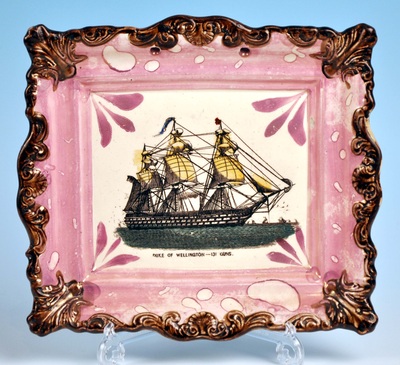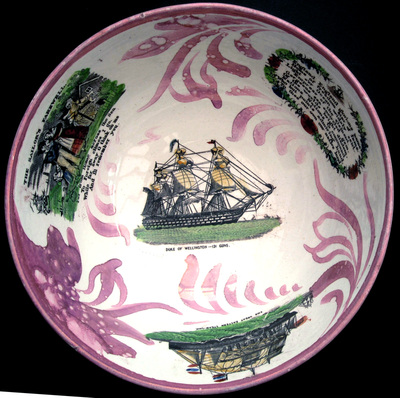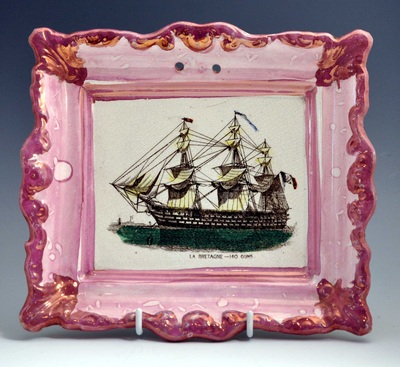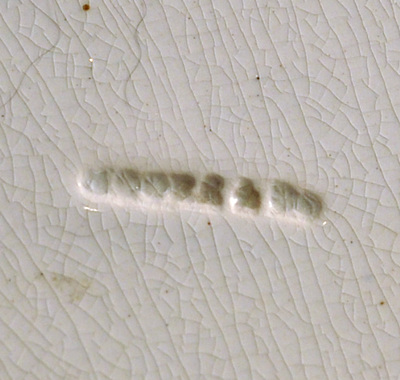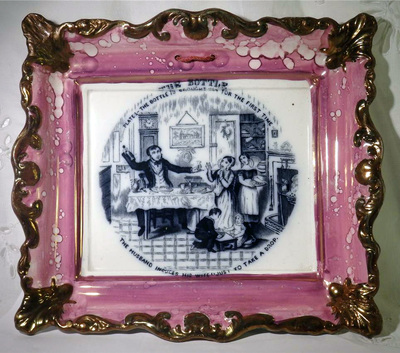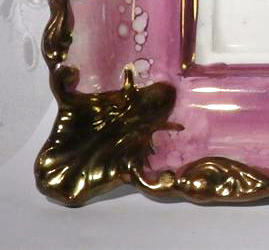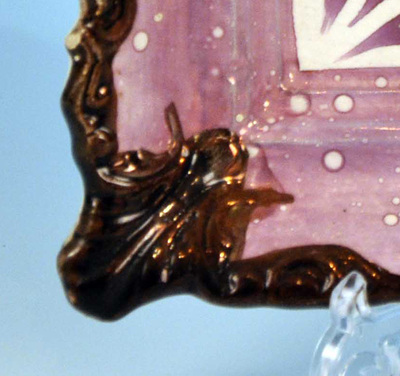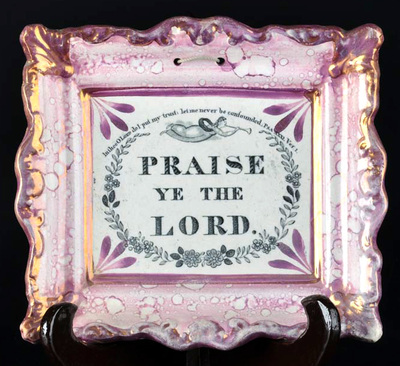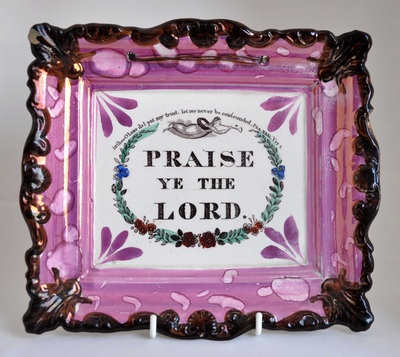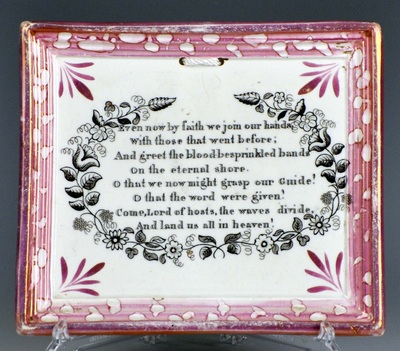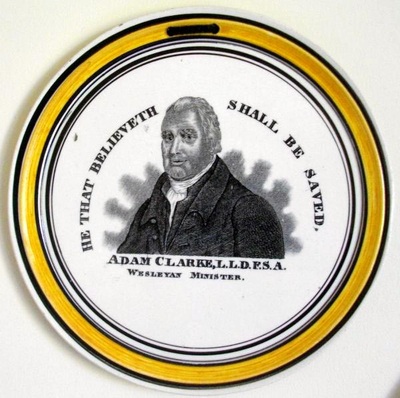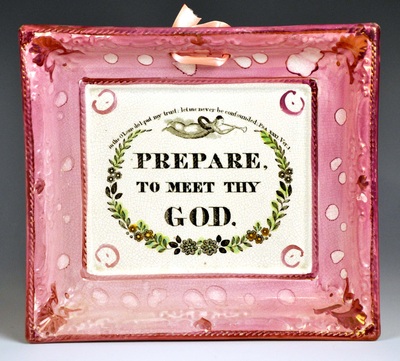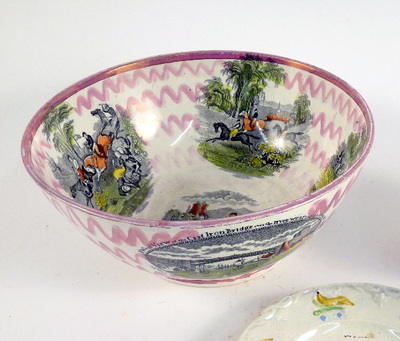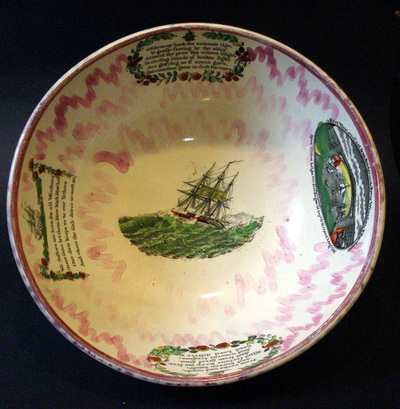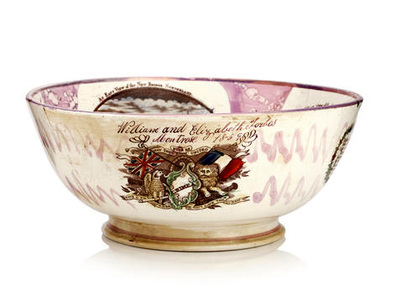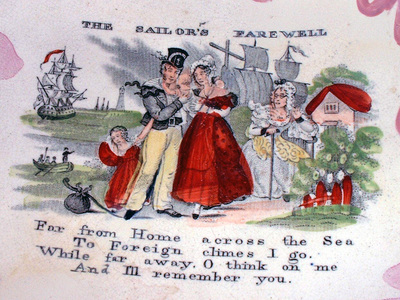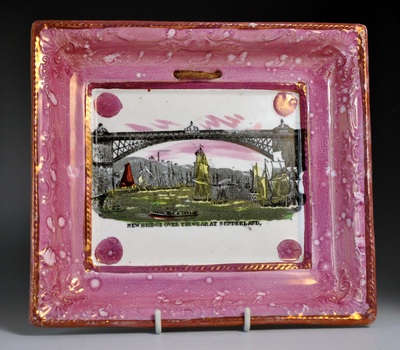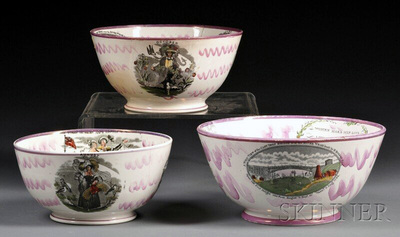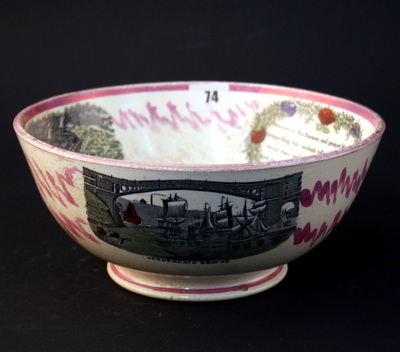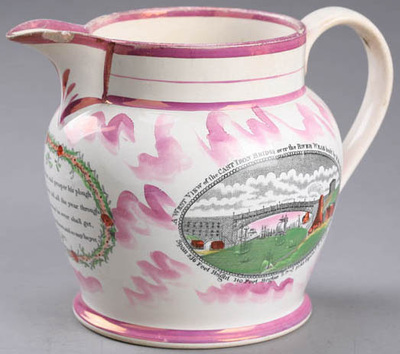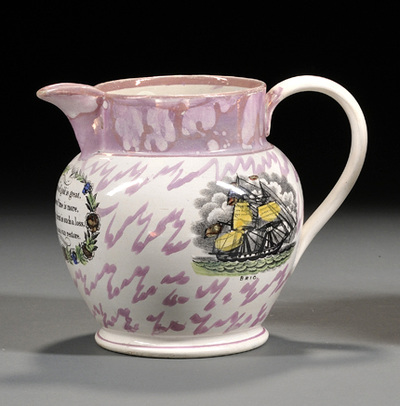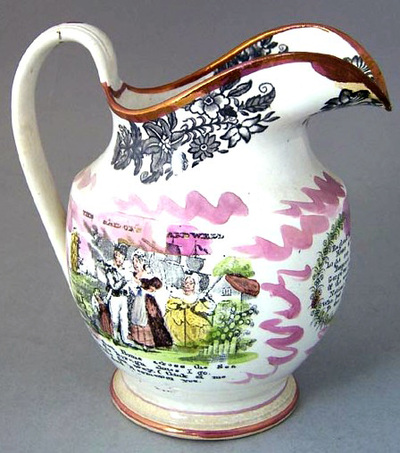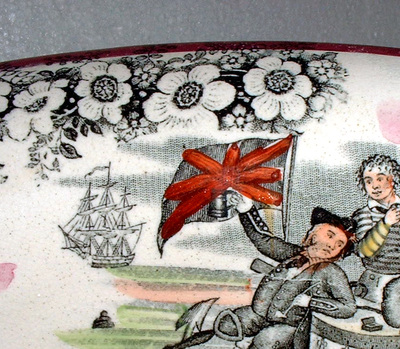|
I've spent weeks (years) thinking about the transfers shared by Scott and Moore in the 1860s. The brown-bordered plaques (left below), made during that period, are probably most associated with the series of common ship transfers. Those transfers rarely appear on items with the Moore impress, and yet frequently appear on bowls with Scott impressed marks (right below) and on the jugs that pair with them. For this reason, the brown-bordered plaques, which are never marked, are almost universally attributed to Scott. I'm now as certain as I can be that's wrong, and have set out the reasons below. 1. Moore's made marked items with the ship transfers in the 1850sThe two plaques below, which pre-date the brown-bordered plaques, both have 'Moore & Co' impressed marks. As does the bowl from Bonhams, with ship transfers and the date inscription, 1859. This evidence alone would be enough to make the case, were the attribution of the brown-bordered plaques to Scott not so widely held. The Moore-impressed items are relatively rare, which is why I believe they've been overlooked. 2. Moore's made similar looking plaques in the 1850sAlthough there's no evidence of Moore's using the larger rectangular mould of the brown-bordered plaques during the 1850s, they made smaller plaques with almost identical lustre decoration. Compare the corner of the Bottle plaque (top centre) which has a Moore printed mark, with that of a plaque with brown borders (top right). Also, compare the decoration on the 1850s' Moore plaque (bottom left), with that of the brown-bordered plaque with the same transfer. 3. There are very few plaques attributable to Scott from the 1850sThe only plaque forms firmly attributable to Scott's are those with group 1 transfers (see three examples below). The first two were likely made in the 1830s or 40s. We know from examples of the last plaque form with hand-painted dates that they were made from c1858 onwards. Scott's doesn't appear to have made plaques during the early- to mid-1850s (unless they continued to make the earlier plaque forms for longer than imagined). So it seems fair to say that Scott's had a very limited stake in making plaques. And the plaques it did produce look nothing like the brown-bordered plaques. 4. There are very few bowls marked Moore from the 1860sMoore's made a fair number of bowls during the 1840s and 50s (see below), but appears to have stopped making them in the early 1860s. This proves nothing in itself, but might hint at a division of labour during this transfer-sharing period, with Scott's making bowls and jugs, and sending them to Moore's for decoration. With Moore's, meanwhile, focussing their efforts on making plaques, as they'd done so prolifically during the 1840s and 50s. 5. The majority of transfers on brown-bordered plaques originated at Moore'sAs discussed in my June 29 post, the majority of the transfers that appear on the brown-bordered plaques, which are traceable to earlier wares, originated at Moore's. There's no obvious reason to believe that Moore's would cede such a large number of transfer plates to neighbouring Scott's. Isn't it more likely that Moore's continued to decorate items with its own transfers? The simplest answer is always the best. 6. Scott's transfers don't appear on brown-bordered plaquesIf Scott's made the brown-bordered plaques, why didn't they decorate them with their own transfers? The Scott group 1 transfers never appear on brown-bordered plaques. Not even the Prepare to Meet Thy God (plate 1) that was used well into the 1870s. The Scott versions of the Sailor's Return and Farewell and associated transfers (see left below) and the Scott months (see right below) never appear in conjunction with the common ship transfers, nor on the brown-bordered plaques. And yet, Scott was widely using these transfers at the time the brown-bordered plaques were produced. The only good reason for these two groups of transfers remaining so completely discrete, is that the copper plates were held at different locations. 7. The lustre decoration on jugs and bowls with ships matches Moore itemsLustre decoration is more difficult to pin down, and it seems likely that both potteries had several people (women? children?) decorating items with lustre. But each pottery had a different house style. Moore's decoration tends to be in long unbroken lines of zig-zag markings (see below left), whereas Scott's tends to be more fluid and curvy, with marks in shorter bursts (see below centre). The Scott items with ships (below right) tend to have 'Moore' decoration. 8. The ship transfers never appear with Scott's flowersAlthough both Scott's and Moore's decorated jugs, mugs and bowls with flowers in the 1840s and 50s, only Scott's continued into the 1860s. Scott's flowers from that period (see left and centre below) never appear in conjunction with the ship transfers, whereas they commonly appear with the Scott group 1 transfers. Scott's made large numbers of jugs and bowls during this period, and decorated some themselves with their own (group 1) transfers and flowers. They appear to have sent others to Moore's for decoration with ships (below right), and those items never appear with Scott flowers. 9. Moore's was a bigger pottery than Scott'sDuring the 1860s Moore's went through a period of modernisation and expansion. A manager called Ralph Seddon from Staffordshire was appointed, and 'on his advice the works were largely rebuilt and equipped with modern machinery'. Between 1866 and 1872 the pottery was reported to be the largest on Wearside. Operating at full capacity, Moore's could have employed up to 250 hands, although was reported to have 180 during this period, whereas Scott's employed about 150 (Baker). If we put aside the decoration of plaques, jugs and bowls with ship transfers, we still have a clear idea of what Scott's was doing in the 1860s. They potted a large number of jugs, ewers, and bowls, and they decorated many of them with their own (group 1) transfers, often with typical flower decoration. They made their own particular rectangular plaque form, and decorated those plaques with the group 1 transfers. But what else was Moore's, the larger pottery, doing during that period? If you subtract the brown-bordered plaques, and decorating items for Scott's, very little remains by way of lustre items. However, according to Baker, it wasn't until 1875 that Moore's 'concentrated chiefly on making dinner sets of various patterns, abandoning what it considered the old-fashioned transfer-printed pink lustreware'. Moore's had the capacity to make the brown-bordered plaques, and to take in pottery from other factories for decoration. Aside from doing that, it's unclear what else the pottery was producing, by way of lustreware, during this period of technological improvement and expansion. 10. Records show that Scott's sent items to Moore's for decorationBaker writes that 'the transfers used by Scott's were frequently the same as those used by the nearby Wear (Moore's) Pottery. Moreover, according to the firm's records Scott's supplied earthenware to Moore's Wear Pottery [...] presumably plain for decoration.' The group of transfers that Baker is referring to are those that appear on brown-bordered plaques. There's no evidence of sharing of Moore's or Scott's transfers from the 1840s. And there's no evidence of Scott's sharing its group 1 transfers, until c1870, and the orange lustre period. I'm still waiting for a response from the Sunderland Museum regarding the records Baker referred to. However, regardless of the date of the records (if they are indeed dated), I believe, for all of the reasons above, that there's compelling evidence that Scott's sent items to Moore's for lustre decoration in the 1860s. Having finally come out of the closet with a Moore attribution for the brown-bordered plaques, I have hours of work to do correcting the information on this site. And in case you thought it was all neatly sewn up, there's still the issue of the group 2 plaques in my June 14 post. Did those transfers originate at Scott's, Moore's, Dixon's or Newbottle High Pottery, or another Sunderland Pottery not yet considered?
Thanks to anyone who has read this far. If you have evidence against my reasoning above, I still am, and always will be, happy to consider it.
1 Comment
|
AuthorStephen Smith lives in London, and is always happy to hear from other collectors. If you have an interesting collection of plaques, and are based in the UK, he will photograph them for you. Free advice given regarding selling and dispersal of a collection, or to those wishing to start one. Just get in touch... Archives
February 2022
AcknowledgementsThis website is indebted to collectors, dealers and enthusiasts who have shared their knowledge or photos. In particular: Ian Holmes, Stephen Duckworth, Dick Henrywood, Norman Lowe, Keith Lovell, Donald H Ryan, Harold Crowder, Jack and Joyce Cockerill, Myrna Schkolne, Elinor Penna, Ian Sharp, Shauna Gregg at the Sunderland Museum, Keith Bell, Martyn Edgell, and Liz Denton.
|
